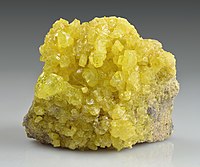
Photo from wikipedia
Transition metal sulfides (TMSs), owing to their high theoretical specific capacity, unique chemical and physical properties, were established as promising anode materials for potassium-ion batteries. However, the large volume expansion… Click to show full abstract
Transition metal sulfides (TMSs), owing to their high theoretical specific capacity, unique chemical and physical properties, were established as promising anode materials for potassium-ion batteries. However, the large volume expansion of the well-crystallized TMSs has an important influence on the structural stability during cycling. Herein, amorphous cobalt sulfide/N-doped carbon core/shell nanoparticles (ACSNPs) are obtained and work as preeminent anode and display excellent potassium storage performance. After 200 cycles, the ACSNPs show a reversible capacity of 253.4 mAh g−1 at 50 mA g−1, with a much better cycling stability than commercial cobalt sulfide. Amorphous cobalt sulfide wrapped in a N-doped flexible carbon shell not only suppresses the aggregation of small grains, but also confines the cobalt sulfide particles and inhibits large volume expansion during K-ion intercalation/deintercalation.
Journal Title: Journal of Materials Science
Year Published: 2020
Link to full text (if available)
Share on Social Media: Sign Up to like & get
recommendations!